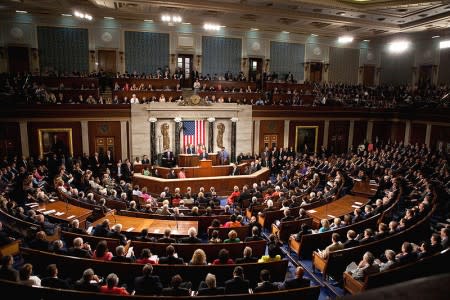Impeachment 101: The history, the facts, the process
Debate for the past week about a possible drive in the House to file impeachment charges against President Obama has brought new attention to one of Congress’ most-important powers.
On Sunday, Republican Steve King brought up the subject in a TV interview about a potential executive order about immigration.
“None of us want to do the thing that’s left for us as an alternative,” King said on Fox News Sunday. “But if the president has decided that he simply is not going to enforce any immigration law … I think Congress has to sit down and have a serious look at the rest of this Constitution and that includes that “I” word that we don’t want to say.”
Article I, Section 2, of the Constitution gives the House of Representatives the sole power to bring charges against civil officials, including the President and even a Supreme Court Justice. Article I, Section 3, assigns the Senate the power to try an official brought up on impeachment charges.
In the case of the President, the Chief Justice of the United States presides over the trial. In other situations, the Senate is the judge and jury.
The Senate must find the person guilty by a two-thirds voting margin; the main punishment is removal from office, and disqualification from holding future offices is also a potential punishment.
During the Constitutional Convention, the Founders debated the best method to use impeachment as a critical tool in the checks and balances process.
James Madison wanted the Supreme Court, and not the Senate, to conduct impeachment trials. But Alexander Hamilton and other delegates wanted the new government to stick with the English tradition of using the upper house of the legislature to conduct trials.
However, in the English tradition, anyone could be impeached and tried, and the death penalty was an option.
The Founders restricted who could be impeached and convicted by Congress, and the penalties. They also created a general framework, and limited the charges to crimes such as “treason, bribery or other high crimes and misdemeanors.”
The phrase “high crimes and misdemeanors” has been controversial since 1789, when the First Congress met. The Impeachment clauses had their first big test in 1805, when Supreme Court Justice Samuel Chase was acquitted after being charged by the House.
The House said Chase impaired defense witnesses in two politically sensitive cases, and promoted the Federalist Party agenda from the bench by “tending to prostitute the high judicial character with which he was invested, to the low purpose of an electioneering partizan.”
The sitting Vice President, Aaron Burr, presided over the trial, which set a precedent for judicial independence by denying President Thomas Jefferson’s desire to remove Chase for political reasons.
In 1868, President Andrew Johnson survived a politically charged impeachment trial in the Senate after he clashed with the Radical Republicans. Johnson was accused of violating the Tenure of Office Act (a law he vetoed) and was found not guilty in the Senate by the slimmest of margins. The Supreme Court later found the act unconstitutional.
In early August 1974, impeachment proceedings in the House were moving along quickly against President Richard Nixon, after the Watergate scandal came to a head with the imminent release of the Watergate Tapes. The House Judiciary committee passed three articles of impeachment, to be presented to the entire House for a vote. On August 8, 1974, Nixon resigned after the tapes showed evidence of a cover up, avoiding the public spectacle of an impeachment.
The 1999 impeachment and trial of President Bill Clinton hinged on two charges related to perjury and obstruction of justice allegations. The House approved the two charges, but the Senate wasn’t close to finding Clinton guilty, falling 22 votes short on one charge and 17 votes on another charge.
The Clinton incident also resulted in 1998 mid-term election losses of five House seats and House Speaker Newt Gingrich’s resignation as voters reacted to the impeachment debate in Washington.
There have been other officials who have been impeached by the House and tried by the Senate. In all, 15 federal judges have been impeached since 1789. A total of eight were convicted by the Senate, four were acquitted by the Senate, and three resigned before an outcome at trial.
Also, in 1799, Senator William Blount was impeached, but he had already been expelled from the Senate. And in 1876, Secretary of War William Belknap was acquitted by the Senate after he had already resigned his cabinet position.
In the current Senate, there are enough Democrats expected to be seated in the next session of Congress to block any vote against President Obama in a theoretical impeachment trial. Current House Speaker John Boehner has said repeatedly he has no plans to seek impeachment charges against President Obama.
Recent Historical Stories on Constitution Daily
President Obama’s use of executive orders in historical terms
Constitution Check: Can states exempt themselves from federal gun laws?


